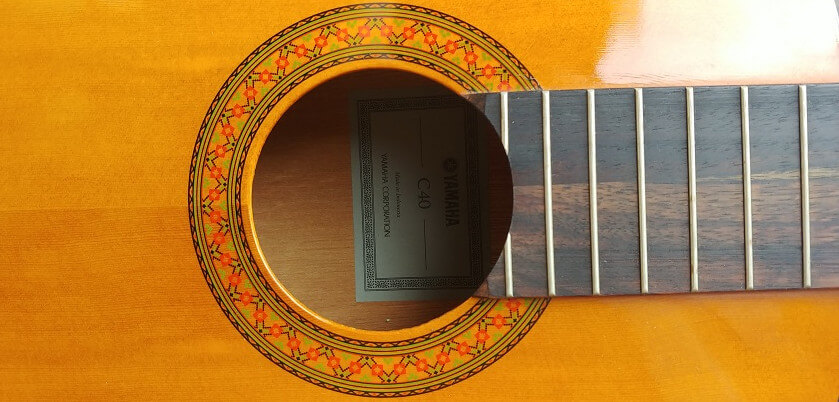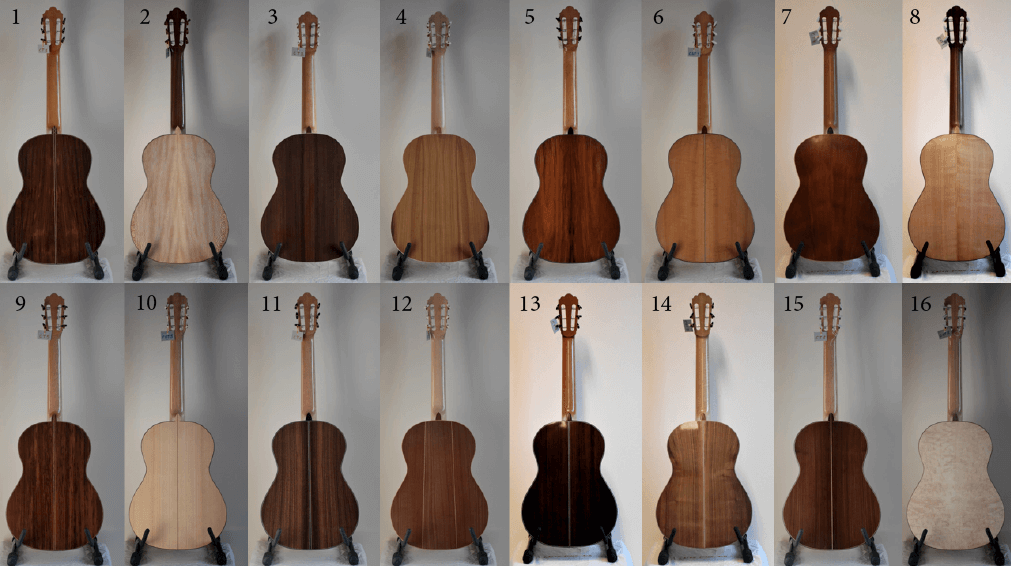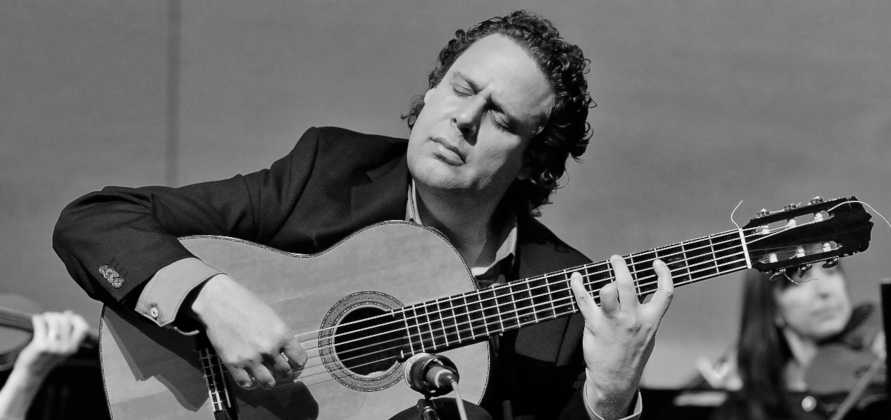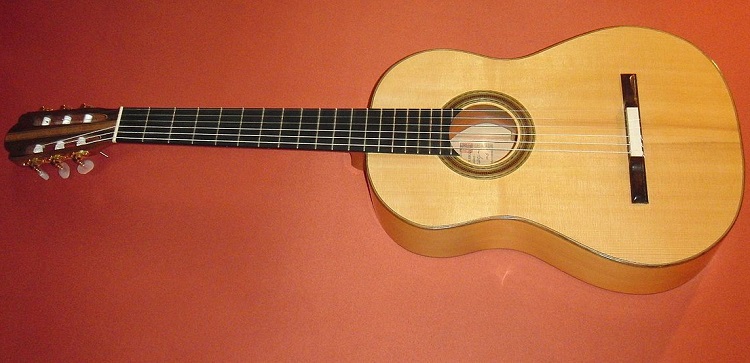One of the first things a guitarist does when weighing up an instrument is to look at the type of wood. Yet few will consider the bracing that sits just under the soundboard.
Bracing refers to the wooden strips of wood that are glued to the inside of the guitar. They strengthen the top, which vibrates in response to the plucked strings, and help shape the overall sound.
There are many bracing patterns used in guitars but they all must strike a balance between strengthening the guitar top without stifling the oscillation that pumps sound waves towards the listener. The combination of wood, soundboard and struts (as well as the overall design) will highlight certain harmonics.
The way a guitar top vibrates, and the impact of bracing, has been studied extensively over the past four decades by Dr Bernard Richardson at Cardiff University.
“The important thing in a soundboard design is that in using a strutted plate you can achieve the necessary resilience required to resist the deformations of the strings pulling on the bridge (and twisting the soundboard) and also provide the necessary stiffness required for the normal acoustical action but at the same time keeping the vibrating mass of the plate to a minimum,” Dr Richardson told Inside-guitar.com.
“That’s the real art of the luthier – getting that balance between necessary stiffness and lightness.”
Dr Richardson’s research provide ground-breaking insights for luthiers, which go beyond the scope of this article. However, those insights also allow guitarists to better understand their instruments and appreciate the challenges luthiers face when shaping tone.
Classical guitar fan bracing
Antonio Torres, who set the foundation for modern guitar design in the late 19th century, used three systems of strutting, according to luthier José L. Romanillos writing in his book, Antonio de Torres, Guitar Maker: His Life and Work.
His best guitars had seven radial struts in the fan shape (and two diagonal ones) while the other two designs had five radial struts. Other well-known luthiers have made guitars with four, six, seven, eight, nine and 11 struts.
The inside of the beginner-focused Yamaha C40 classical guitar pictured below shows a simple fan bracing design with four struts on the lower bout running down either side of the center join of this laminated spruce top. The photo directly below it shows the Artist Guitar CL44PK AM model, which has five struts.
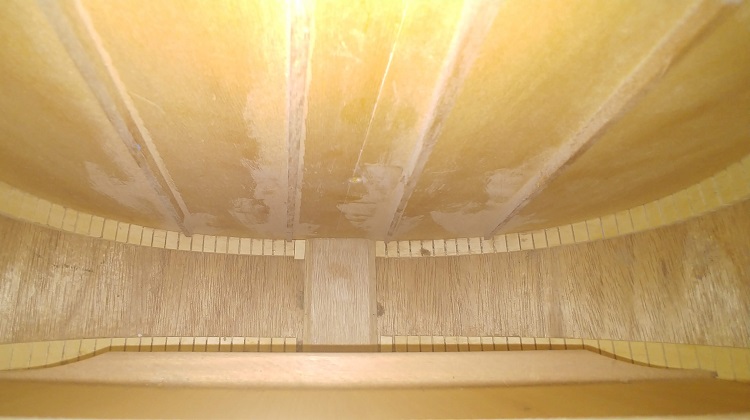
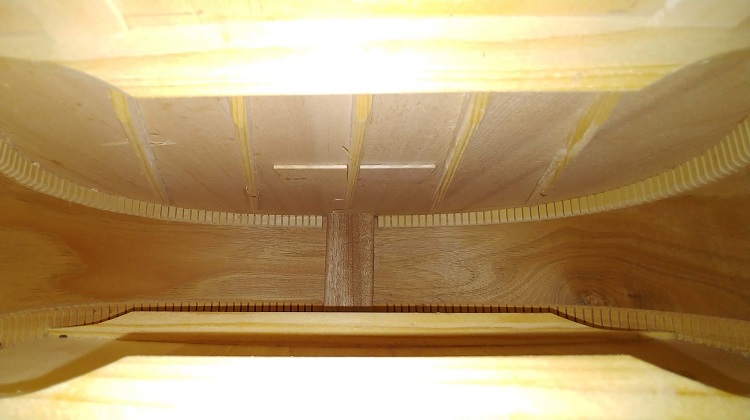
What is not visible in these photos is the soundboard thickness – and an indication of its stiffness – to gauge the impact of the strutting system. This is something Dr Richardson has done on several different soundboards using high-tech equipment (see below).
Flamenco guitar fan bracing
Now compare those two beginner nylon string guitars with the inside of the professional level Rafael Romero model below.

It’s also immediately clear how much better quality the spruce wood is compared to the two beginner guitar models above. This isn’t meant to be an unfair comparison, given the Rafael Romero guitar is considerably more expensive than the two beginner guitars.
It still has the fan popular nylon string fan bracing, but there are seven struts which are highly refined in shape. An extremely thin, almost transparent soundboard supported by (usually seven) thin fan struts is a traditional flamenco style also found in guitars made by Santos Hernández, Domingo Esteso, and Marcelo Barbero, according to Romanillos.
“This technique is essential for the percussive quality required in the ideal flamenco guitar to avoid the ‘feedback’ of vibrations from the soundboard to the string,” according to José L. Romanillos writing in his book about Torres.
“The flamenco guitar maker, ideally, has to produce a soundboard that ‘dies’ after the note has been plucked to achieve a distinctive explosive note, the energy being used in a single percussive blow.”
Steel string acoustic X bracing
The steel string Yamaha Epiphone acoustic guitar below shows the classic X bracing shape. Steel strings place far more pressure on the top than nylon strings, and so require stronger bracing.
The X shape bracing was first employed by Martin Guitars, which records some of the bracing history on its site and in a video.
Luthier Trevor Gore, who is also an engineer, says X bracing on a dreadnought style guitar tends to create a scooped effect: a strong bass and treble response, but with a surpressed mid-range.
“For something like bluegrass, it’s actually great because it allows room for voices, other instruments, in that scoop,” he recently told the Luthier on Luthier podcast. “It’s also great for guitars used for strumming. If you have a full mid-range on a strumming-type guitar, you tend to get a very muddy and muddled sort of sound because there’s just too much going on.”
Guitarists need to still be aware that every guitar is unique and the impact of one component on sound – such as the bracing pattern – can be offset by another.
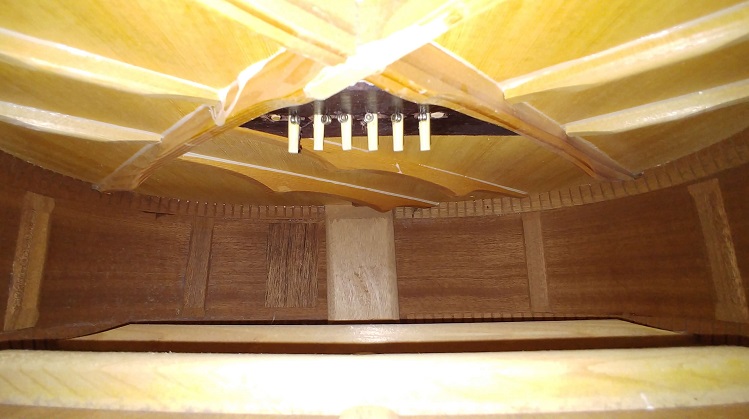
Capturing the soundboard’s vibration on camera
The exact way each guitar body vibrates in response to a plucked string helps determines the instrument’s sound quality. Internal bracing is a key factor, alongside the properties of the wood, the size of the soundboard, and its thickness.
This body vibration, and how it differs between guitars, has been captured on camera using holographic interferometry by Dr Richardson at the Cardiff University’s School of Physics and Astronomy acoustics group.
The way the guitar body moves is complex, but it can broken down into unique resonance frequencies or mode frequencies. These are the particular frequencies that maximize the guitar’s motion.
The images below, from the 2002 paper Input admittance and sound field measurements of ten classical guitars, shows how five common soundboard designs vibrate at their fundamental mode. The vibrational plot points are similar to a map’s contour lines.
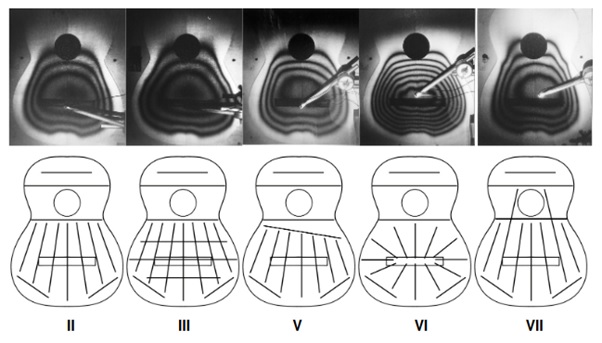
Soundboard II is a standard Torres design; III is a Lattice design; V a Ramirez design; VI a Radial design; and VII an Extended Torres design. These are subtle but important differences that affect the sound in complex ways, which can be seen in the images.
One of the most interesting findings of this research was that each guitar had its own character but were all quality instruments that produced a quality tone – it just depends on what the guitarist prefers.
“There’s no one formula which makes a ‘good guitar’,” Dr Richardson says. “It’s like good wine – there are lots of equally-good wines which all taste different. And then there’s also bad wine.”
No one strutting pattern can guarantee a particular type of response – it comes down to the overall correct balance between stiffness and mass distribution of the soundboard itself (which the strutting helps shape).
Guitars are complex instruments and internal bracing is just one factor that affects the tone and overall quality. But it’s always worth considering what’s inside a guitar to reveal some basic elements that the outside can never reveal.
- [IDEAL FOR BEGINNERS] Whether learning your first chords or writing songs, the FG800J is the ideal…
- [QUALITY CRAFTMANSHIP] From carefully chosen woods to beautiful, hand-applied finishes and detailed…
- [SOUND] The FG800J’s solid spruce top and large body yields a bright, balanced tone and bold…
- It’s strong enough to stand up to the everyday use that beginning players might throw its way thanks…
- This guitar also features scalloped “X”-bracing, mahogany neck.
- It features a durable dark-stained maple fingerboard to give you an instrument that looks as good as…


